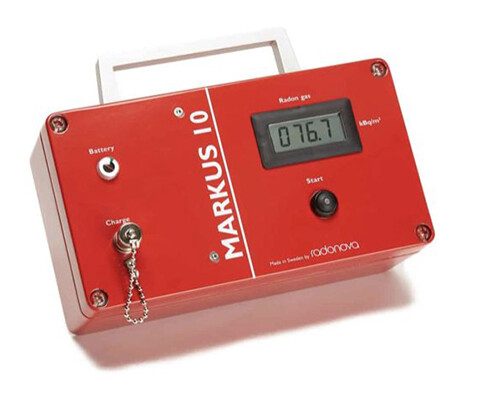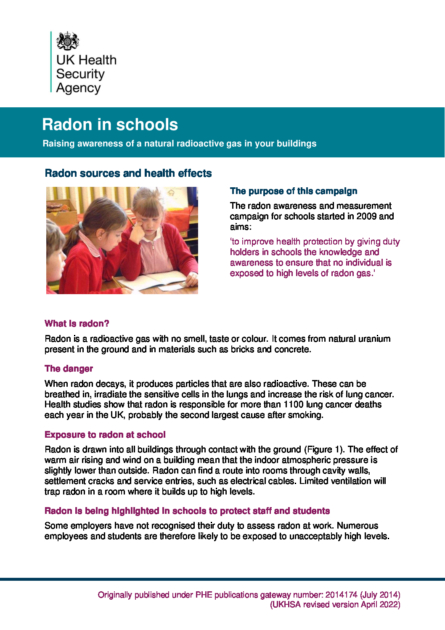School Fined for Radon Overexposure
School Fined £50,000 for Radon Gas Overexposure.
The Health & Safety Executive published a press release yesterday detailing that a school had been fined for radon gas overexposure – Read More
A private boarding school has been fined £50,000 after exposing two employees, five pupils, and two other children to high levels of radioactive radon gas.
Five pupils at Kingswood School in Bath, Somerset were exposed to levels of radioactive radon gas almost 8 times the legal limit. Two other children, who were not pupils at the school, were exposed to levels of radon gas almost 14 times the legal limit. Two employees were exposed to radioactive radon gas ¾ of the legal limit. Exposures to radiation need to be kept as low as reasonably practicable.
The radioactive gas radon is a hazard in many homes and workplaces and breathing in radon is the second largest cause of lung cancer in the UK resulting in over 1,000 fatal cancers per year. Radon is a colourless, odourless, radioactive gas that occurs in rocks and soils, some building materials and water. The ground is the most important source as radon can seep out and build up in houses and indoor workplaces like schools.
The legal limits for radiation exposure in the workplace are defined in The Ionising Radiations Regulations 2017 (IRR17).
These exposures to radioactive radon gas occurred in 2019. The two employees and their two children were exposed to the elevated radon gas levels as a result of working and living at the school. The five overexposed pupils studied and lived at the school during this time.
An investigation by the Health and Safety Executive (HSE) found that the school knew they had a radon problem as far back as 2007 when they carried out monitoring and installed some remediation to reduce radon levels. However, from 2010 to 2018 the school carried out no subsequent radon monitoring and had no systems in place to ensure radon control measures were adequate. Only following HSE intervention in 2018 did the school find out about their previous radon problem and further radon monitoring and remediation was carried out to reduce radon levels.
Kingswood School Trustees Limited, of Lansdown, Bath, Somerset pleaded guilty to breaching Section 2(1) and 3(1) of the Health and Safety at Work etc Act 1974. The company was fined £50,000 and was ordered to pay £19,222 costs at a hearing at Taunton Magistrates’ Court on 19 July 2023.
After the hearing, HSE Principal Specialist Inspector (Radiation) Stewart Robertson, said: “The fine imposed on Kingswood School Trustees Limited should underline to everyone in the education sector that the courts, and HSE, take a failure to follow the regulations extremely seriously.”
“We will not hesitate to take action against companies, including schools, who do not do all that they should to keep people safe. Every workplace needs to consider radon as a risk to its employees and others.”
Know Your Radon Risk
This press release highlights why it is critical that all schools, boarding schools and universities know their radon risk and act to ensure that pupils, employees and visitors are kept safe.
Radon Risk Assessments for Schools & Universities
Radon is a serious issue throughout the UK. Whilst every building contains some level of radon the levels are usually low, so the risk to health is small. However, in some parts of the country e.g. Bristol, areas of Wales, Cumbria, and parts of the Peak District to name a few, buildings and grounds may have higher levels of radon and there may be a need for radon monitoring in specific areas.
If you own or manage a workplace The Management of Health and Safety at Work Regulations 1999 requires every employer to make a suitable and sufficient assessment of the risks to the health and safety of employees whilst at work and other people (such as students) on site. All schools, universities, and education providers need to complete an appropriate Risk assessment. This should include radon if the school is in a radon affected area or has an occupied basement. Universities should also ensure that their student accommodation is radon risk assessed.
You can find out more information regarding Radon in the Workplace and who is responsible for risk assessments here
You need to make sure that you have completed a radon risk assessment. This includes all schools, universities, and education providers.
Radon Risk Assessments, Surveys and Monitoring
But How Do You Know if Your School Building, Land, or Grounds Has Higher Levels of Radon?
If you have identified that your school or university is in a high risk area, how do you identify the specific radon risk?
Earth Environmental & Geotechnical work with Local Authorities, Property developers, housing associations, schools, and employers to help identify the radon risk for your property or building development. We provide a comprehensive range of Radon Survey, Detection, and Monitoring Services.
Including using MARKUS 10 instruments that allows for in-situ measurement of radon gas in soils. The Markus 10 can provide a clear understanding of the radon levels in the soil of your School site and can quickly allow for an informed decision on whether the site requires radon mitigation measures.
For further information on radon monitoring and detection for School buildings and Universities please contact Earth Environmental & Geotechnical now
Don’t Forget your Radon Risk Assessments for Schools & Universities should always include any basement that is occupied. Testing must be carried out if your school or university has a basement or cellar, regardless of geographic location.
Earth Environmental & Geotechnical: MARKUS 10 instrument Allows for in-situ Measurement of Radon Gas in Soils.
If you are planning any development on your School site or University land the Markus 10 can provide a clear understanding of the radon levels in the soil of your development site and can quickly allow for an informed decision whether the development requires radon mitigation measures.
The Radon Atlas shows the bands of radon risk in each 1 kilometre grid square of England and Wales. This is only a coarse gridded assessment of radon potential, defined as the estimated percentage of homes in an area above the radon action Level. The risk is indicative, not definitive, and the atlas shows the whole 1km grid square according to the highest radon potential.
The advantage of the Markus 10 is that it provides the actual radon measurements specific to the soil of the development site. The equipment can be used to map the whole site to provide a clear and accurate understanding of the actual radon levels and then informed decisions can be made if radon mitigation is required and how extensive they need to be.
The Markus 10 will measure the radon content within 14 minutes after starting the measurement and only 18 minutes waiting time is required between each measurement.
The instruments are particularly good for pre planning ground investigation work and can be used before designs or construction works start on new developments or brownfield land development. In-situ testing allows for an enhanced assessment of radon potential of shallow soils rather than sole reliance on the Radon Atlas.
Using the Markus 10 when assessing development land could mean that a site that may not look viable according to the Radon Atlas actually is or that any radon issues are captured at the pre planning phase so development designs can be adapted before designs are finalised for planning applications.
Earth Environmental & Geotechnical provides a wide range of Radon Monitoring, Detection and mitigation services click here to contact us for further information. Act Now
Check Your Postcode Now
How To Safeguard Your School Against Radon:
Step 1 – Check – is your School or University in a Risk Area. Enter your school or University Post Code.
Don’t forget to click the SHOW RADON DATA red button on the left-hand side.
Step 2 – Measure – if your School or University is in a Radon Risk Area you need to take Radon Measurements
Step 3 – Act – If your result is at or above the UK Action Level of 300 Bq m-3
You can find out more information here
Don’t Forget your Radon Risk Assessments for Schools & Universities should always include any basement that is occupied. Testing must be carried out if your school or university has a basement or cellar, regardless of geographic location.
Radon Risk Assessments for Schools, Education Providers & Universities
Actions for Schools in radon Affected Areas
Employers should carry out three–month radon measurements in the premises for which they are responsible, which have been identified as being in radon Affected Areas. Even with radon potential maps, no one can predict the radon level in an individual building, so the only way to know for sure is to place a number of small radon monitors throughout the school.
The Government has produced documentation regarding Radon in schools – Raising awareness of a natural radioactive gas in your buildings.
It is the responsibility of all schools and Universities to ensure that you know if your school or University is in a Radon affected area
At Earth Environmental & Geotechnical we have a comprehensive range of Radon Survey services for Schools, Academy Trusts, education providers, and Universities. If you would like further advice contact us to discuss your Radon Risk Assessment Needs.
Recently Updated Radon Map for Great Britain
The UK Health Security Agency (UKHSA) and the British Geological Survey (BGS) have published an updated radon potential map for Great Britain.
In December 2022 the UK Health Security Agency (UKHSA) and the British Geological Survey (BGS) published an updated radon potential map for Great Britain, the first update in 10 years.
The risk of developing lung cancer from exposure to radon remains low and the vast majority of buildings remain outside Affected Areas.
Individuals and employers are encouraged to check the map to see if a radon test is advised in homes and workplaces in their area.
Postcodes have moved into High Risk Areas so please check now!
The updated radon potential map, produced by UKHSA and BGS, is the first in over 10 years and provides an authoritative analysis of the likelihood of a building being in a radon Affected Area (an area with higher radon potential).
Radon is a colourless and odourless gas that is attributed to 1,100 lung cancer deaths per year in the United Kingdom. The risk is highest among smokers and ex-smokers.
For most people, the risk of developing lung cancer from exposure to radon remains low and levels of radon have not increased across the UK. However, UKHSA advises you to test your home if you live or work in an Affected Area. There are several methods of reducing high radon levels in buildings.
The latest update to the map, available to view at UKradon.org, is the product of years of new analysis and research, combining the latest geological mapping with one of the largest databases of in-home measurements ever compiled.
While the vast majority of buildings remain outside radon Affected Areas, this new map has refined our knowledge of areas where high radon levels are more likely to occur. The overall number of buildings with high radon levels remains the same.
The radon map allows local councils, national and regional governments, social and private landlords, private homeowners, and employers to assess the radon risk in their properties. It is also used in building regulations to inform where radon preventative measures should be incorporated in new buildings.







